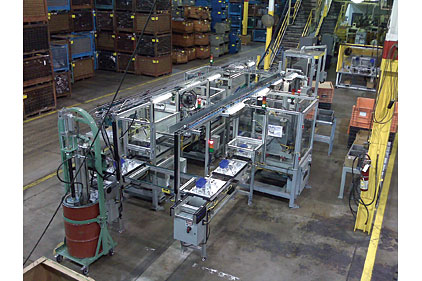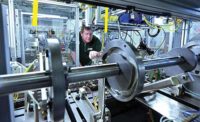
|
|
Programmable automationcontrollers and
standardized, high-speed networks have enabled
engineers to take a modular approach to designing
assembly machines. Photo courtesy LTW Inc.
|
This approach is not the easiest system to optimize, but it does have its advantages, particularly if the application requires synchronized motion between multiple axes. Such applications include six-axis robots, injection molding machines, milling machines and water-jet cutting machines.
For an automated assembly system, however, engineers would prefer to take a modular approach to machine design. A modular system is more flexible, faster to change over, and—for medical device assembly—easier to validate and simpler to clean.
“With a modular system, it’s easier to diagnose an issue,” says Chris Knudsen, product marketing supervisor at Yaskawa America Inc. “You can isolate a problem to a specific module instead of a whole line. And, if the module is critical to your process, you can have a spare ready to go in case of a problem or sudden bottleneck.”
For the machine builder, a modular approach means less development time, smaller component inventories, and the ability to integrate a wider range of machine functions. Machine builders can also rough out common modules, such as pick-and-place units, in advance of a project.
A modular system consists of a series of cells or modules. Each cell has its own control—a programmable automation controller (PAC). A PAC is a compact controller that combines the features and capabilities of a PC-based control system with that of a typical programmable logic controller (PLC). PACs are available from a number of companies, including Yaskawa, Beckhoff Automation, Opto 22 and Schneider Electric.
“A modular system has more of a distributed control system vs. a centralized control,” explains Knudsen. “PACs have become smaller, more connectable and less expensive, and you can now afford to just pop one of these controls into each module, as opposed to one big, fancy controller running the entire system. So you might have a line with five PACs and one PLC that’s just monitoring the whole line.”
“With a modular system, it’s easier to diagnose an issue.”—Chris Knudsen, Yaskawa America Inc.
High-speed networks, such as Ethernet/IP, Modbus and OPC, have supplanted point-to-point wiring in assembly systems and enabled engineers to take a modular approach to design. “Network speeds are now close to the speed of PC or PLC backplanes,” says Knudsen. “These open network standards also ensure interoperability.”
On the software side, standardized, object-oriented programming environments, such as IEC61131-3, are well-suited for modular machine design. IEC61131-3 has been adopted by numerous suppliers, including Yaskawa, Siemens, Bosch Rexroth, Schneider, Beckhoff, Omron, Mitsubishi Electric, and B&R Industrial Automation.
“Object-oriented programming means that the code is modularized,” says Knudsen “Think of an object as a subroutine. You feed it some variables and it spits out an answer, but you don’t necessarily need to know everything that’s going on inside the subroutine.”
Is a modular system faster than centralized control? “There’s a speed advantage within the module, because you have this controller that’s handling everything just for that module,” says Knudsen. “There may be a slight speed disadvantage when synchronizing the motion of each module. In a traditional system, if I want to synch, say, Axis 9 with Axis 1 and Axis 2, I would be doing it across the backplane of the controller, which is immune to noise and very fast. That’s why a milling machine will have a central controller, because it’s got to synchronize everything very tightly.
“On the other hand, a traditional system will eventually max out on axis count, I/O count and scan times.”




